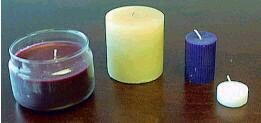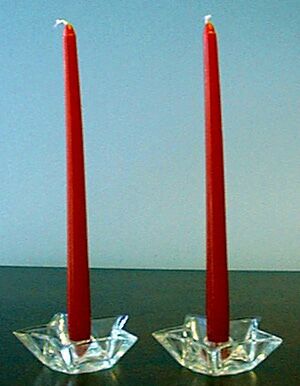The U.S. Consumer Product Safety Commission (CPSC) voted unanimously to ban the manufacture and sale of lead-cored wicks and candles with lead-cored wicks. CPSC determined that candles using lead-cored wicks could present a lead poisoning hazard to young children. The federal ban, which applies to all domestic and imported candles, should deter manufacturers from making non-conforming wicks, allow the U.S. Customs Service to stop shipments of non-conforming wicks and candles, and allow for the CPSC to seek penalties for violations of the ban.
"Over the past 30 years, CPSC has been at the forefront of protecting the nation's children from the hazards associated with lead," said CPSC Chairman Hal Stratton. "The ban of lead-cored candlewicks should give parents with young children peace of mind that the burning of votive, pillar or container candles will not emit a dangerous toxin."
A CPSC investigation found that despite a voluntary industry agreement in the 1970s to remove lead from candle wicks, a small percentage of candles sold in the past several years still contained lead-cored wicks. CPSC staff found that some lead-cored wicks could emit relatively large amounts of lead into the air during burning. Children may then inhale the vaporized lead, placing them at risk. Children may also be exposed to lead by mouthing objects on which lead has settled or by handling such objects and then mouthing their hands.
Some of the candles tested by CPSC staff emitted lead levels in excess of 3,000 micrograms per hour - about seven times the rate that could lead to elevated levels of lead in a child. CPSC estimates that an indoor air lead level of 430 micrograms per hour from burning candles could result in hazardous exposure to children.
Lead poisoning in children is associated with behavioral problems, learning disabilities, hearing problems and growth retardation. Although the primary source of lead poisoning in the United States is lead from paint in older homes, lead accumulates in the body, and even exposure to small amounts of lead can contribute to the overall level of lead in the blood.
Safe alternatives to lead-cored wicks, including zinc, synthetic fibers, cotton and paper, are used by most candle and candle wick manufacturers. Currently, candles that use a metallic core in the wick most likely contain zinc. Because consumers cannot tell if a metal- cored wick contains lead or an alternative, consumers may wish to contact the retailer for information about the materials used in their candles.
The CPSC was petitioned to ban candlewicks containing lead cores and candles with such wicks by Public Citizen, the National Apartment Association, and National Multi Housing Council on February 20, 2001. The ban against manufacturing, importing, or selling candles with lead wicks will become effective in October 2003.
 Some container, pillar, votive, and tealight candles use metal wicks and CPSC found that some contained lead. |  Tapers, commonly used as dinner candles, use cotton wicks and do not contain lead. |
About the U.S. CPSC
The U.S. Consumer Product Safety Commission (CPSC) is charged with protecting the public from unreasonable risk of injury or death associated with the use of thousands of types of consumer products. Deaths, injuries, and property damage from consumer product-related incidents cost the nation more than $1 trillion annually. CPSC's work to ensure the safety of consumer products has contributed to a decline in the rate of injuries associated with consumer products over the past 50 years.
Federal law prohibits any person from selling products subject to a Commission ordered recall or a voluntary recall undertaken in consultation with the CPSC.
For lifesaving information:
- Visit CPSC.gov.
- Sign up to receive our e-mail alerts.
- Follow us on Facebook, Instagram @USCPSC and Twitter @USCPSC.
- Report a dangerous product or a product-related injury on www.SaferProducts.gov.
- Call CPSC’s Hotline at 800-638-2772 (TTY 301-595-7054).
- Contact a media specialist.
Please use the below phone number for all media requests.
Phone: (301) 504-7908
Spanish: (301) 504-7800
